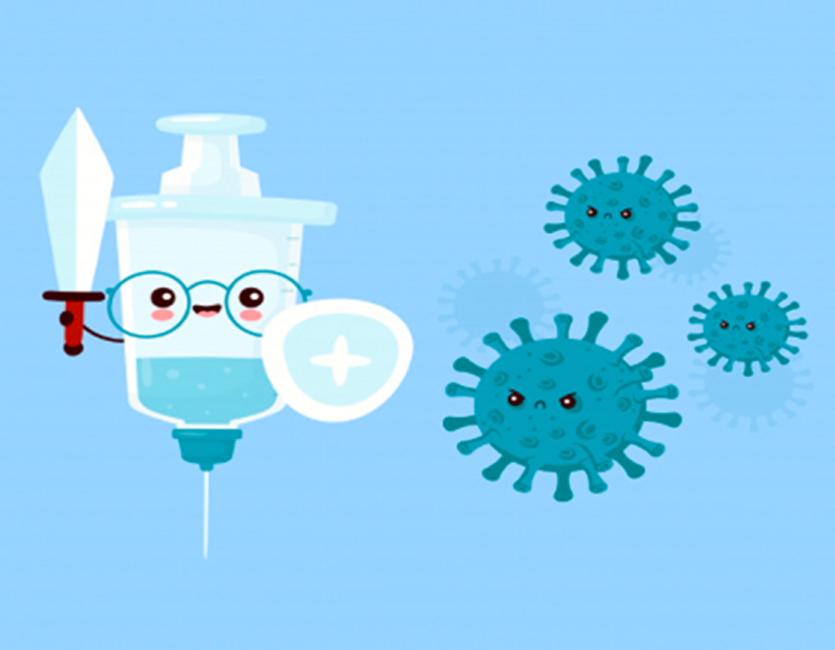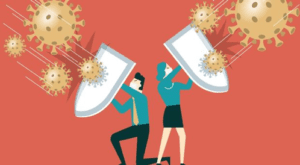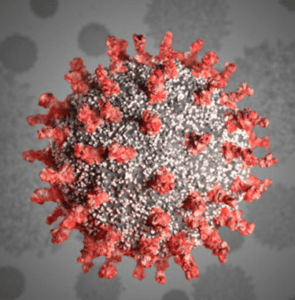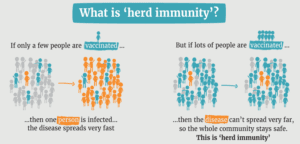The Science Behind Vaccines and Your Immune System
Category Blog | Time 4 Minutes | Published January 08, 2021

By Molly Perski
One of the most important discoveries we’ve made in the field of medicine is the vaccine! Vaccines are used to help prepare our immune systems to fight off harmful or deadly pathogens that may potentially infect us. It might surprise you to learn that the very first vaccine was actually developed all the way back in 1796 by Edward Jenner to protect people against smallpox! This early method involved taking fluid from a blister of someone infected with cow pox and inoculating it into another person’s skin (there is actually evidence to suggest that people were using similar versions of this type of treatment as early as 200 BC!) Vaccines didn’t start becoming routinely recommended to the general public until the early 1900’s, but the process was streamlined in the 1940s so that large-scale vaccine production could occur in order to start mass disease control efforts.
The practice of healing and medicine dates back thousands of years, each culture having their own unique way of curing ailments and procuring remedies.
 With the new covid-19 vaccination becoming available, many people have found themselves with handfuls of unanswered questions about how it works, why it’s effective, and if there are risks to taking it. In order to understand how a vaccine works, we need to understand our immune system. Simply put, your immune system protects your body from pathogens and foreign invaders like bacteria, viruses, fungi, and toxins. If one these manages to get inside your body, your immune system springs into action to fight it off before it can spread and make you sick or cause an infection.
With the new covid-19 vaccination becoming available, many people have found themselves with handfuls of unanswered questions about how it works, why it’s effective, and if there are risks to taking it. In order to understand how a vaccine works, we need to understand our immune system. Simply put, your immune system protects your body from pathogens and foreign invaders like bacteria, viruses, fungi, and toxins. If one these manages to get inside your body, your immune system springs into action to fight it off before it can spread and make you sick or cause an infection.
There are 2 main components to our immune system. The first is our innate immune system which is the immune system we are born with, and the second is our adaptive immune system which your body develops as it’s exposed to different microbes. It senses when foreign microbes or pathogens enter our body and responds by producing cells called antibodies that protect you by fighting off that specific invader. After your first exposure to the illness, the antibodies stick around and help your body to recognize and fight it off quickly if it ever returns. This is the basis for how vaccines work in our body! They help us develop immunity by imitating an infection from a pathogen so our body can produce the proper antibodies and learn to fight off the real thing when the time comes!
Now that we have a more basic understanding of how our immune system works and how vaccines prep them to ward off diseases, let’s talk more specifically about the new COVID-19 vaccine. As many of us have heard, this new COVID vaccine is what’s known as an mRNA vaccine. While this is one of the first vaccines to utilize this technique, scientists have been studying mRNA vaccines for decades! This type of vaccine is of key interest because it can be developed in a laboratory using readily available materials. This allows the production process to be standardized and scaled up more efficiently and speeds up the development of producing the vaccine over the traditional methods. Let’s take a closer look at what mRNA is and how this type of vaccine works.
Most of us know that DNA is what codes for our genetic information, but what is RNA? RNA is the intermediate step in the body’s process of taking DNA and making proteins. DNA is comprised of 4 nucleotides (adenine, thymine, cytosine, guanine) that are each paired with a 5-carbon sugar and a phosphate molecule and then arranged into different patterns to create our genetic code! RNA is very similar to DNA, but there are 2 main differences between the two. The first is that DNA has a “deoxyribose” sugar while RNA has a “ribose” sugar. The second has to do with its nucleotides. RNA uses 3 of the 4 same nucleotides as DNA (adenine, guanine, and cytosine) but has a unique 4th nucleotide called “uracil” tha replaces “thymine”. RNA is created through the process of “transcription” which takes a strand of DNA and uses it as a template to make a new strand of RNA using the RNA nucleotides. This RNA strand then acts as a messenger (that’s what the “m” in mRNA stands for!) and takes this genetic template it obtained from the DNA over to these subunits within our cells called “ribosomes” that use it to make protein! These proteins are then integrated into the cell or sent out into the body. Now that we understand this important concept, we can look more closely at how mRNA vaccines like the new COVID-19 vaccine work.
 The COVID-19 virus is covered in proteins (known as “spike proteins”) that help the virus to latch on to and penetrate a healthy cell so it can replicate, and they signal to our immune system that the virus is present which triggers an immune response. This is why the new COVID-19 vaccine is specifically targeting these spike proteins! The way the mRNA COVID-19 vaccine works is it provides our body with the RNA template that is used by the virus to make the spike protein (NOTE: the spike protein is not what makes you sick!) so that our immune system can become familiar with them and produce the antibodies needed to fight off the real virus down the line (this is our adaptive immune system at work!) It’s important to note that a vaccine is not the same thing as a cure—it’s job is to prevent diseases, not to treat them. If you’ve had the vaccine, it doesn’t mean that you’re unable to contract the disease it’s protecting against, it just makes it a lot less likely that you will. When enough people are vaccinated and are less likely to contract a disease, the population develops a “heard immunity” which works to keep everyone safe and prevent mass spreading.
The COVID-19 virus is covered in proteins (known as “spike proteins”) that help the virus to latch on to and penetrate a healthy cell so it can replicate, and they signal to our immune system that the virus is present which triggers an immune response. This is why the new COVID-19 vaccine is specifically targeting these spike proteins! The way the mRNA COVID-19 vaccine works is it provides our body with the RNA template that is used by the virus to make the spike protein (NOTE: the spike protein is not what makes you sick!) so that our immune system can become familiar with them and produce the antibodies needed to fight off the real virus down the line (this is our adaptive immune system at work!) It’s important to note that a vaccine is not the same thing as a cure—it’s job is to prevent diseases, not to treat them. If you’ve had the vaccine, it doesn’t mean that you’re unable to contract the disease it’s protecting against, it just makes it a lot less likely that you will. When enough people are vaccinated and are less likely to contract a disease, the population develops a “heard immunity” which works to keep everyone safe and prevent mass spreading.
 After you receive a vaccine, it takes time for our immune system to familiarize itself with it and to create the proper immune response (antibodies) necessary to fight it off again in the future. Some vaccines, like the COVID-19 vaccine, require additional injections to maximize its effectiveness. Because of this, it’s possible for people who are newly vaccinated to still catch the virus since their bodies haven’t built up the proper immune response yet (NOTE: this doesn’t mean the vaccine caused them to become sick).
After you receive a vaccine, it takes time for our immune system to familiarize itself with it and to create the proper immune response (antibodies) necessary to fight it off again in the future. Some vaccines, like the COVID-19 vaccine, require additional injections to maximize its effectiveness. Because of this, it’s possible for people who are newly vaccinated to still catch the virus since their bodies haven’t built up the proper immune response yet (NOTE: this doesn’t mean the vaccine caused them to become sick).
Until we establish a better heard immunity, it’s important that we continue to do our part by washing our hands, wearing our masks, and practicing social distancing.

Burcham Hills’s Management Company becomes J.D. Power’s most awarded brand in the history of its Senior Living Satisfaction Study
News • November 21, 2023
Life Care Services ranked #1 in Independent Living, for the fifth year in a row, and added a #1 ranking for Assisted Living/Memory Care in the 2023
Read Article

Age Is Just a Number: Five Signs It's Time for Assisted Living
Blog • February 27, 2023
Modern senior living communities are comfortable, pleasant places to live and offer wonderful amenities and services. Today's assisted living is
Read Article

Top Five AI-Generated Considerations for Your Senior Living Search
Blog • March 08, 2023
Artificial intelligence (AI) is a technology that allows a computer or robot to mimic human actions or intelligence. With more than 50 years of
Read Article
